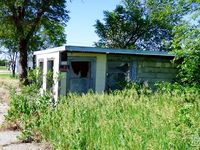Hutchinson Air Force Station
|
Hutchinson Air Force Station (1952-1968) - A Cold War Air Force Radar Station first established in 1952 near Hutchinson, Reno County, Kansas. Named Hutchinson Air Force Station after the location. Collocated with the now-closed Hutchinson Naval Air Station. Initially assigned a Permanent ID of P-47, later a Sage ID of Z-47. Abandoned in 1968. Now known as Hutchinson FAA Radar Site. HistoryEstablished on 1 May 1951 as Hutchinson Air Force Station manned by the 793rd AC&W Squadron and became operational in May 1952. The station initially had both a Ground-Control Intercept (GCI) and early warning mission. The early warning mission involved tracking and identifying all aircraft entering their airspace while the GCI mission involved guiding Air Force interceptors to any identified enemy aircraft. Controllers at the station vectored fighter aircraft at the correct course and speed to intercept enemy aircraft using voice commands via ground-to-air radio. Initial equipment included two FPS-10 search/height-finder radars. In 1958 the FPS-3 search radar and a pair of FPS-6A height-finders were installed. The FPS-3 was upgraded to an FPS-20. In 1959 Hutchinson AFS was also performing air traffic control duties for the Federal Aviation Administration (FAA).
SAGE System TransitionThe transition of the manual GCI system to the automated SAGE system began with the installation of the FST-2 coordinate data transmitter and search radar upgrades. The FST-2 equipment digitized the radar returns and transmitted the digital returns to the SAGE direction center. Under the SAGE System, interceptor aircraft were directed to their targets by the direction center computers and controllers, greatly reducing the need for local controllers and equipment at every radar station. The FST-2 was a very large digital system using vacuum tube technology. Over 6900 vacuum tubes were used in each FST-2 requiring 21 air-conditioned cabinets, 40 tons of air conditioning, 43.5 kva of prime power, and usually a large new addition to the operations building. The FST-2B modification added two more cabinets but with newer solid-state (transistor) technology to process coded responses from aircraft transponders. SAGE System OperationThe site began operation as a SAGE site in January 1961 initially feeding the Sioux City SAGE Direction Center DC-22. The search radar was upgraded to an FPS-66 and an FPS-26A height-finder radar was installed replacing one of the FPS-6As. ClosureThe 793rd Radar Squadron was deactivated on 8 Sep 1968 and the Air Force Station closed on 30 Sep 1968. Hutchinson FAA Radar SiteThe FAA acquired a small compound that included the search tower and a height-finder tower and continued to operate the site as Hutchinson FAA Radar Site. The FPS-66 was replaced with a Common Air Route Surveillance Radar (CARSR) circa 2015. A FYQ-47 Common Digitizer was probably placed in service by February 1973 when the USAF/FAA FST-2 to FYQ-47 replacement program was completed. By 1990 the site was equipped with an FPS-66A search radar and a CD-2A Common Digitizer. The Hutchinson CD-2A was scheduled to receive an upgrade kit to implement three level weather data processing on 27 Apr 1990. CARSR RadarThe nationwide replacement program converting FAA legacy radar systems to the CARSR radar configuration was completed by 17 Aug 2015 and Vandenberg FAA Radar Site was a part of that program. Legacy FAA radars underwent a Service Life Extension Program (SLEP) that replaced key components in the vintage ARSR-1, ARSR-2, FPS-20, FPS-66 and FPS-67 radars. The CARSR program replaced legacy klystron radar transmitters with a solid-state transmitter as well as renovating the radar receiver and signal processor. The CARSR modification also included common digitizer functionality making a separate common digitizer unnecessary. The Vandenberg FAA Radar Site is now operating with the CARSR radar. The secondary radar at this site is an ATCBI-6 Beacon set. The radar site data is now available to the USAF/NORAD Battle Control System-Fixed (BCS-F) operations centers (EADS & WADS) as well as the FAA Kansas City ARTCC (ZKC) and adjacent ARTCCs. Other federal agencies have access to the data under the Homeland Security umbrella. Gap FillersHutchinson AFS was responsible for the maintenance of two remote unattended gap-filler radar sites. The gap-filler sites were placed in locations where the main search radar lacked coverage. These sites sent digitized radar target data directly to a direction center. Maintenance teams were dispatched from Hutchinson AFS for regularly scheduled maintenance or when fault indicators suggested the site had problems. The Hutchinson AFS gap-filler radars were located at Ellsworth and Wilsey, Kansas.
Physical PlantThe physical plant of the site was divided into the main site, a cantonment area, a housing area, and a radio site. The main site housed the operations buildings, the radar towers, and the backup generators. The cantonment area housed the enlisted barracks, the bachelor officer's quarters, the orderly room, the dining hall, the motor pool, and other support buildings. Apart from the main site was a small housing area for critical married personnel. A separate Ground to Air Transmitter/Receiver (GATR) radio site housed the radio equipment for directing aircraft intercepts.
Current StatusThe Cantonment area is now the Hutchinson Community College and Area Vocational School, The FAA still operates a radar at the main site. The housing area is now privately owned homes.
See Also:
Sources:
Visited: 8 Jun 2015
| ||||||||||||||||||||||||||||||||||||||||||||||





